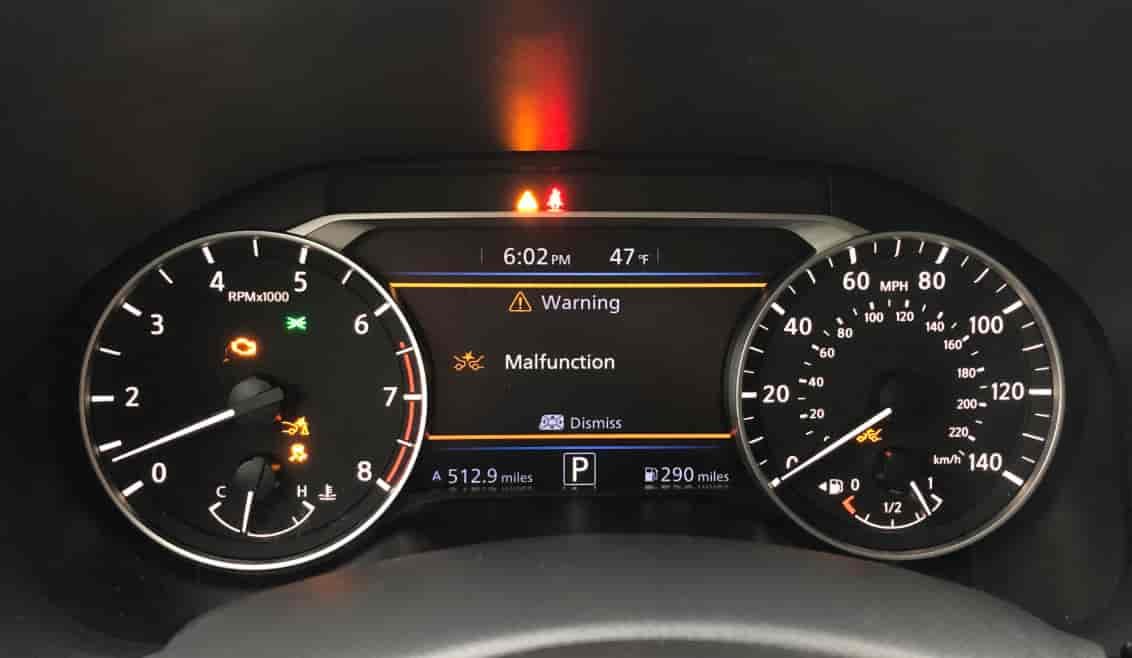Have you ever been driving your Nissan Altima when suddenly the “Malfunction” light appears on the dashboard? For many drivers, this warning creates instant stress and confusion. Is it something serious or just a minor issue?
The Nissan Altima malfunction warning is part of the car’s onboard diagnostic system, designed to alert you when something is not working properly. While it might seem like a small light, it can indicate anything from a loose gas cap to a potential engine problem.
Ignoring the malfunction indicator could lead to higher repair costs or even engine damage over time. That is why understanding what this warning means and how to respond quickly can save you both time and money.
In this complete guide, you will learn exactly what the Nissan Altima malfunction warning means, the most common reasons it appears, and step-by-step methods to fix it fast. Whether you drive an older Altima or a brand new model, this guide will help you diagnose and handle the problem with confidence.
What Does the Nissan Altima Malfunction Warning Mean
The malfunction warning light in your Nissan Altima, also known as the Malfunction Indicator Light or MIL, is part of the car’s self-diagnostic system. When it appears, it means the onboard computer has detected an issue affecting the engine, emission system, or related components.
In simple terms, the light is your car’s way of saying something is not running as it should. Sometimes it can be a minor issue, such as a loose fuel cap, but in other cases it may signal a more serious problem with sensors, spark plugs, or the catalytic converter.
When the malfunction warning turns on, it can either stay steady or flash. A steady light usually indicates a minor issue that still requires attention, while a flashing light means a more urgent problem that could damage the engine if you keep driving.
It is important to note that the malfunction warning is not always the same as the “Check Engine” light. In many Nissan Altima models, both warnings are connected but represent different diagnostic messages. The best approach is to treat both as serious alerts and investigate them as soon as possible.
Common Causes of the Malfunction Warning in Nissan Altima
Understanding what triggers the malfunction warning in a Nissan Altima is the first step toward solving the problem quickly. This alert can appear for several reasons, ranging from minor maintenance issues to more serious mechanical faults. Checking the most common causes can save both time and unnecessary repair costs.
A loose or damaged gas cap is one of the simplest and most overlooked reasons for the malfunction warning. When the fuel system is not sealed properly, it creates a pressure imbalance that the car’s sensors interpret as a fault. After refueling, always tighten the gas cap until you hear it click securely, as this often clears the warning on its own.
A faulty oxygen sensor is another frequent cause. This sensor measures how much oxygen remains in the exhaust and helps the engine maintain the right fuel-to-air ratio. When it fails, the readings become inaccurate, leading to higher emissions, poor fuel economy, and the appearance of the malfunction indicator. Replacing a bad sensor usually restores normal performance.
Worn spark plugs or damaged ignition coils can also trigger the warning light. Misfiring cylinders reduce power, waste fuel, and send incorrect signals to the engine control unit. These ignition problems are among the most common reasons for persistent malfunction alerts and should be addressed as soon as possible.
Catalytic converter issues can also cause the warning to appear. The converter filters harmful gases, and when it becomes clogged or inefficient, the system detects poor exhaust flow. This condition requires professional diagnosis because it can affect both emissions and engine temperature.
A malfunctioning mass airflow sensor is another likely source. This component measures the amount of air entering the engine, and if it fails, the engine may idle roughly, hesitate, or enter limp mode. Cleaning or replacing the sensor often resolves the issue. Finally, weak battery voltage or unstable electrical connections can cause false alerts, especially after a battery replacement or jump-start. Performing a quick system reset usually clears the message once the voltage stabilizes.
By checking these common causes in order of simplicity, you can often identify and fix the malfunction warning without extensive repairs. Regular maintenance and timely inspections help keep your Nissan Altima running smoothly and warning-free.
How to Fix the Nissan Altima Malfunction Warning Fast
Once you understand what the malfunction warning means, the next step is fixing it correctly. Many of these issues can be resolved without a trip to the mechanic if you follow the right process. Here is how to handle it effectively.
Step 1: Check the Gas Cap
Start with the simplest fix. Turn off the engine and make sure the gas cap is properly tightened. If it is cracked or damaged, replace it. After tightening the cap, restart the car and drive for a few miles. In many cases, the warning light will disappear on its own once the system rechecks pressure levels.
Step 2: Scan for Error Codes
If the light remains on, use an OBD-II scanner to read diagnostic trouble codes (DTCs). These codes identify the exact component causing the warning. You can buy an affordable scanner or visit an auto parts store where they often provide this service for free. Make note of the codes for further reference.
Step 3: Inspect Common Problem Areas
Check key components like spark plugs, oxygen sensors, and the mass airflow sensor. If any of them look dirty or worn, clean or replace them. Most of these parts are inexpensive and can be replaced at home with basic tools.
Step 4: Perform a System Reset
After addressing any issues, clear the warning light using your OBD-II scanner or by disconnecting the car battery for about ten minutes. Reconnect it, start the engine, and see if the light stays off. If it does not reappear after driving for a while, the issue has been resolved.
Step 5: Visit a Certified Nissan Service Center
If the malfunction warning continues after these steps, it might be linked to deeper electronic or engine problems. In this case, a certified Nissan technician can perform a full diagnostic scan to detect underlying faults before they cause further damage.
Nissan Altima Malfunction Warning After Battery Change
Many Nissan Altima owners notice that the malfunction warning appears right after replacing the battery or performing a jump start. This can be alarming, especially when everything else seems to be working fine. In most cases, however, this alert does not indicate a serious problem.
When the battery is disconnected or replaced, the car’s Electronic Control Unit (ECU) loses stored memory related to fuel trim, idle speed, and other adaptive settings. Once the new battery is installed, the ECU needs time to relearn these parameters. During this short adaptation period, the system may trigger a temporary malfunction warning.
To fix this, make sure the battery terminals are clean and securely connected. Start the engine and let it idle for about 10 to 15 minutes without using electrical accessories such as air conditioning or headlights. Then take a short drive so the ECU can recalibrate sensor data.
If the malfunction warning remains on after several driving cycles, you may need to perform a manual reset using an OBD-II scanner. However, if the warning persists even after resetting, have a technician inspect the alternator and voltage regulator to ensure the charging system is functioning properly.
Prevention Tips: Keep Your Nissan Altima Warning-Free
Preventing the malfunction warning from appearing again is much easier than dealing with it after it lights up. By following a few simple maintenance habits, you can keep your Nissan Altima running smoothly and avoid unnecessary stress. Consistent care helps the vehicle’s sensors and systems work together accurately, reducing false alerts and improving long-term performance.
Regular maintenance is the most effective way to prevent warning messages. Following Nissan’s recommended service intervals ensures that the engine control unit receives accurate data from all sensors. Routine oil changes, filter replacements, and system inspections help detect real issues early before they develop into costly problems. A well-maintained engine rarely triggers false warnings.
Keeping sensors and key components clean also makes a big difference. Dust and debris can interfere with sensors such as the oxygen sensor or mass airflow sensor, causing incorrect readings. Cleaning these parts periodically helps maintain the correct air-to-fuel balance and prevents unnecessary alerts from appearing on the dashboard.
Using high-quality fuel and genuine replacement parts supports consistent performance. Low-grade fuel or cheap components can affect combustion quality and sensor accuracy, leading to malfunctions or poor engine response. Always choose fuel that meets Nissan’s octane rating and use certified replacement parts during repairs.
It is also important to check the battery and charging system. Weak voltage or corrosion on the terminals can confuse the vehicle’s electronics and cause false warnings. Testing the battery regularly during maintenance visits can prevent many electrical issues before they appear.
Finally, drive smoothly and pay attention to small performance changes such as rough idling or hesitation. Aggressive driving or ignoring minor problems can stress the engine and sensors over time. Gentle acceleration and early troubleshooting keep the car’s systems balanced and reduce the risk of future warnings.
Conclusion
The malfunction warning in your Nissan Altima is not something to ignore. It is your car’s way of communicating that something needs attention, whether it is a loose gas cap, a worn sensor, or a deeper engine issue. Understanding this warning and knowing how to act quickly can make the difference between a simple fix and a costly repair.
Most of the time, the cause is minor and easy to resolve if handled right away. Checking the gas cap, scanning for error codes, and performing a quick reset are often enough to clear the alert. However, if the light persists or comes back repeatedly, professional diagnosis is the safest option.
By maintaining your Altima regularly, using quality parts, and keeping an eye on early signs of trouble, you can drive with peace of mind and avoid unexpected breakdowns.
Do not let the malfunction warning stress you out. Instead, treat it as an opportunity to keep your Nissan Altima in top condition. Fix it fast, stay proactive, and your car will reward you with years of reliable performance.

